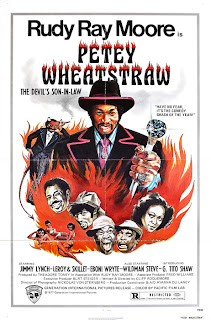In light of Quentin Tarantino's return to blaxploitation with Django Unchained, I thought I would go back and rewatch Jackie Brown. I hadn't seen the movie since 1997 when I originally watched it in the theater. While I thought it a solid effort back then, it wasn't my favorite, especially following the stellar Pulp Fiction. Two factors had me curious about revisiting it: a) I've seen even more movies (and B-movies) since then which might help me plumb the depths with QT a bit more, and I was no longer on the high of QT's sophomore effort.
Based on the Elmore Leonard novel Rum Punch, Jackie Brown concerns an aging down-on-her-luck stewardess' effort to escape a smuggling conviction while also getting out from under the thumb of her gun-running benefactor. With the help of a lonely bail bondsman, Jackie cooks up a plot to rob Ordell, the arms dealer, while selling him out to the ATF. It's a dangerous game to play with the volatile Ordell that's only further complicated by the scheming of Ordell's surfer girlfriend and his ex-con buddy who may be a little iffy on his loyalties.
That's as simple as I can think to put it. The movie is far more novel-like than your average script, a trait that QT would definitely carry over into the films that followed. True, Pulp Fiction certainly played around with narrative structure, but was essentially a series of overlapping shorter tales. Jackie Brown, on the other hand, is a lengthy single narrative that's willing to spend some time swimming in side stories before moving things along. And that's the movie's biggest problem.
I recall when I first saw the movie I described it to others as feeling like the down time in the average blaxploitation movie. It's a common trait of low-budget features: Talk is cheap. When you've got to save money for your action sequences, you can burn time and film just having your actors talk and talk and talk for much less. In most of those old movies this is a liability, as the actors were often either subpar or the extensive talk began to reveal just how thin the story was...or just how painfully stiff that exposition could be. That's not the problem with Jackie Brown. The story is very well layered and the performances are exceptional, but we'll get back to that.
It reminds me of an old maxim Christopher Frayling mentioned in his extensive study of spaghetti westerns: The Italian directors knew that to keep provincial audiences entertained, someone had to get punched or shot every ten minutes. You can practically time some of these films for an upcoming shootout at the ten minute mark from the last one.
I don't, however, wanna give the impression that I was let down by the cast or the characters they portrayed. In fact, revisiting it, I feel like everyone in the movie should've won something for their performances. Pam Grier as Jackie may have mellowed since her Foxy Brown days, but she was still a stone cold customer with a smoldering seductiveness. Robert Forster turns in a stellar performance as the bail bondsman on the verge of retirement, a sympathetic character without a hint of sap. This one was still earlier on the road for Samuel L. Jackson's become SAMUEL L. JACKSON, but he puts in one of the best three-dimensional villains I've ever seen: a deliberate and calculating character, but with a streak of insecurity that's looking for affirmation. And Robert DeNiro and Bridget Fonda are the perfect grimy crime story Cheech & Chong...veritable staples of fringe folks in Los Angeles. They're all great characters, and I enjoyed their banter (particularly scenes between Jackson and DeNiro) and was wowed by their performances.
The cinematography looks great and manages to communicate the different senses of many of the lesser known sections of Los Angeles. And naturally, QT serves up a fantastic soundtrack with frequent use of blaxploitation era favorites. I sometimes wonder if his popularity is tied to feeding the burgeoning love for nostalgia in audiences or that the nostalgia plucked him up and made him the synthesizer king of all things rare and cool. Anyone who regularly reads my posts knows that I too am a sucker for the cinematic arcane, but QT's films, Jackie Brown included, always rise far above the level of the pale imitation or the in-joke.
In all, I was glad I sat back down and spent some time with Jackie Brown. Now that Quentin is a fair few films down the road from it, it was interesting to go back and figure out how and where this film now sits in the mix. If anything, it was a solid and enjoyable adaption while also providing the diving board for both greater experimentation as well as a greater plunge into the depths of genre storytelling.

















